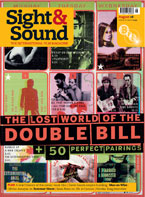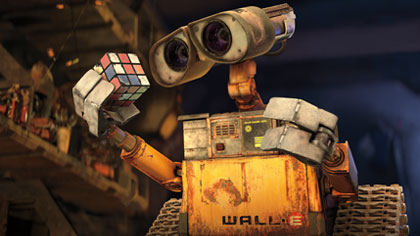
WAll•E
USA 2008

Reviewed by Andrew Osmond
Synopsis
Our synopses give away the plot in full, including surprise twists.
The year 2700. Centuries ago, Earth was deserted by humans after the planet's surface became buried in litter. Only lonely robot WALL•E remains, programmed to compress and shape the refuse into towers. The Earth seems barren but WALL•E finds a single plant in the soil. An automated spaceship descends, unloading EVE, a feminine egg-shaped robot probe who fascinates WALL•E. His attempts to communicate almost cause the trigger-happy EVE to disintegrate him; she is frustrated at being unable to complete some program. WALL•E takes her to his home, showing her his possessions. When he reveals his plant, Eve instantly swallows it; it's what she has been looking for. She shuts down, upsetting WALL•E who obsessively protects her. The spaceship returns to collect EVE. WALL•E clings to the ship's side and is whisked into space, arriving at a massive spaceliner, Axiom, which carries millions of humans. The humans are obese to the point of immobility, wholly dependent on the ship's automated systems. EVE is taken to the ship's captain, who sent her to see if Earth was becoming inhabitable again. However, when he inspects EVE, the plant has vanished. WALL•E and a reactivated EVE hunt for it and find it being dumped in an escape pod set to self-destruct. They save the plant and take it to the captain. It is revealed that OTTO, the ship's autopilot, tried to destroy the plant, acting on a centuries-old secret judgement that Earth would never be clean and humans should stay in space. When the captain disagrees, OTTO imprisons him and tries to dispose of WALL•E and EVE. They escape and lead a revolt of rogue robots. WALL•E is damaged in the ensuing chaos. The captain shuts OTTO down and sends Axiom rocketing back to Earth. EVE rushes WALL•E to his home to repair him. The humans nurture the recovering Earth and WALL•E and EVE live happily ever after.
Review
Near the end of last year's Pixar film Ratatouille, a joyless food critic is spiritually revived by the titular peasant dish. Humbly, he declares to the world that the only thing critics are good for is "discovering and defending the new."The speech, delivered in Peter O'Toole's rich tones, smacked of a cartoon studio simultaneously trumpeting its artistic worth and blowing a raspberry at reviewers who underrated its work.
It's tempting, then, to be sceptical about Pixar's ninth CGI film WALL•E, a future-set saga about the romantic-heroic adventures of a little-guy robot, left to clear up a litter-covered Earth long after all the humans have gone. On the one hand, the film has been sold to us as 'R2-D2 The Movie', though the robot's gormlessly cute appearance is more reminiscent of Johnny Five, the mawkish hero of the 1980s Short Circuit films. Indeed, the eponymous Wall-E recalls both droids, as well as E.T. and the toasters-on-legs of Silent Running (1972). His curiosity about the discarded items people have left behind also qualifies him as an honorary Womble.
At the same time the pre-publicity warned that WALL•E is a 'risky' Pixar film, with little or no dialogue (actually, it has more than we might have expected, and even the empty world where the first act is set is rarely silent). But with so much about WALL•E presold before we even enter the cinema, it seems a bit much to expect reviewers to champion a film backed by a lucrative Hollywood brand.
Annoyingly, WALL•E - from Finding Nemodirector Andrew Stanton,who previously had a less auteurist cachet than Ratatouille'sBrad Bird - is exceptionally good. In fact it's one of Pixar's best films, ranking alongside Toy Story 2 (1999) and The Incredibles (2004). Moreover, it indeed feels 'new', moving out of Pixar's comfort zone while retaining the brand's populist virtues: loveable characters, crafted jokes, aw-shucks niceness and wonderful images.
As the film unfolds, it seems that this story can't work in animation, much as people felt Disney's debut cartoon feature Snow White and the Seven Dwarfs couldn't work in 1937. At first it appears too humourlessly photoreal, too like the live-action 'empty worlds' in films such as I Am Legend (2007). Then WALL•Eseems destined to shunt itself into one-note repetitions of a theme, such as the robot's cute antics in his planet-sized playground or his pratfalling efforts to woo EVE, the white egg-shaped probe (inspired by the sleek lines of iPods) who descends from the sky.
The film's joy, though, is the way WALL•E's situation develops in an organic, lyrical, musical way. The rhythms recall Disney's Bambi (1942), while the audiovisual world - as Stanton acknowledges - is extrapolated from the opening of Star Wars (1977), where a nervously beeping R2-D2 trundles through a strange world of childlike anthropomorphic beings, many of them robotic, who whine and whirr and squeal. The vocalisations in WALL•E are by the same feted sound designer, Ben Burtt, and they're suitably winsome and winning. But it's the appearance of the robots - a male square, a female circle - that the viewer remembers.
The pairing of the clunky WALL•E and the pristine EVE recalls Buzz and Woody in Toy Story, and in the second half of the film there is a lot of chasing around in futuristic interiors à la Monsters, Inc.(2001). The robot protagonists' limited artificial expressions recall Cars(2006), but without the Tootles the Taxiassociations. As in Cars, some of the most lyrical scenes convey the joys of beinga supple piece of metal in motion (one joyous space flight matches anything in Miyazaki Hayao's animation). Conversely, there's a surprisingly dark interlude where WALL•E obsessively cares for EVE when she's shut down and effectively 'dead', with disturbingly funny overtones of Norman Bates.
True, WALL•E's adventures in the cartoon form were anticipated in independent animations, such as Sylvain Chomet's mostly wordless Belleville Rendez-Vous(2003). But WALL•E sets firsts in taking the commercial Hollywood cartoon into new and unexpected places while insisting - as Disney did - on innocent, cute, loveable stars. For all its 2001jokes and SF plotting, the film'sheart is in its beeping babes in the wood. Between them, they make an old brand invigoratingly new. Andrew Osmond
Credits
- Directed by
- Andrew Stanton
- Produced by
- Jim Morris
- Screenplay
- Andrew Stanton
- Jim Reardon
- Original Story
- Andrew Stanton
- Pete Docter
- Directors of Photography
- Camera:
- Jeremy Lasky
- Lighting:
- Danielle Feinberg
- Film Editor
- Stephen Schaffer
- Production Designer
- Ralph Eggleston
- Original Score Composed/
- Conducted by
- Thomas Newman
